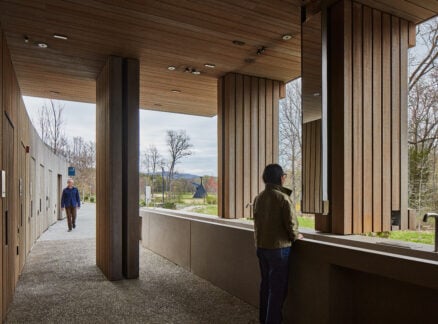
November 10, 2020
Light, Contemporary Interiors Define this Jewelry School
Japanese architect Sou Fujimoto rethinks traditional learning spaces for the L’ÉCOLE, School of Jewelry Arts, campus in Hong Kong.

Paris’s most prestigious educational institution dedicated to jewelry, L’ÉCOLE, School of Jewelry Arts, supported by Paris-based jeweler Van Cleef & Arpels, has opened its first permanent international campus at Hong Kong’s waterfront cultural-retail complex K11 MUSEA.
Japanese architect Sou Fujimoto devised the light and contemporary rethinking of traditional learning spaces, combining his signature serene, minimalist interiors with meticulous architectural detailing over 7,000 square feet arranged throughout two floors.
The upper floor, housing the main reception and offices, is linked to the lower level’s five workshop/classrooms by way of an elegant spiral staircase. The space also has a public lounge, a 600-plus-book library specializing in jewelry and gemstones, and an exhibition gallery that opens onto a terrace.

Interior glass walls that resemble Japanese washi (paper) create a bright and open interior that complements the floor-to-ceiling glazing and frames spectacular views across Victoria Harbour. “The natural light makes it possible to see precious, precise things in a really clear way,” Fujimoto explains. “The light filters through the spaces via the patterned white glass, which is like a representation of sensitivity, delicateness, softness, and at the same time beauty.”
Various classrooms are outfitted with professional workbenches and sophisticated loupes, microscopes, jewelry grading lamps, and ergonomic chairs. The two art history classrooms can be combined into a large theater where experts host conversations and events.
With its architecturally bold and curvaceous silhouette, K11 MUSEA’s facade is reflected in the fluid layout and neutral color and material palette inside. Isamu Noguchi’s sculptural lounge furnishings in the library are a design standout, but the pièce de résistance is Fujimoto’s sushi bar–inspired jewelry display counter: Two narrow oak tables on slender brass legs curve through the center of the gallery. But the deceptively simple, fuss-free linearity and symmetry of the surfaces keep the focus on the jewels.
You may also enjoy “Rafters and Ribbon: A New Home for Blu Dot in Portland.”
Would you like to comment on this article? Send your thoughts to: [email protected]
Register here for Metropolis’s Think Tank Thursdays
and hear what leading firms across North America are thinking and working on today.






